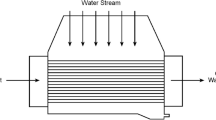Abstract
A brackish water pump impeller was replaced after 4 years of service, while its predecessor lasted over 40 years. The subsequent failure investigation determined that the nickel–aluminum bronze (NAB) impeller was not properly heat treated, which made the impeller susceptible to aluminum dealloying. The dealloying corrosion was exacerbated by erosion, because the pump was slightly oversized. This investigation recommended proper heat treatment of NAB alloys that are to be used in salt water or brackish service. Additionally, the investigation recommended closer evaluation of new pumps to ensure that they are properly sized.
Similar content being viewed by others
Avoid common mistakes on your manuscript.
Background
An impeller from a brackish water pump was removed from service after 4 years of use. The pump was a replacement for the original pump that lasted over 40 years. The replacement pump was slightly oversized, which had the potential to cause erosion or cavitation. The impeller was coated with a brushable ceramic, which was typical for seawater impellers, for additional corrosion resistance and mechanical strength. The pump is a split case, double suction, with equal suction on each side. Pump suction rises from the floor, through a suction strainer, and then flows horizontally to each side of the pump. One suction eye contained more damage than the other. The pump casing was cast iron and the impeller was cast nickel–aluminum bronze (NAB).
Findings
The impeller exhibited severe pitting damage that perforated the vanes (Figs. 1 and 2). The most severe damage was predominately on one suction eye; however, pitting was observed throughout the body. Erosion damage that was characterized by a continuum of overlapping pits was also present throughout the body. Additionally, the ceramic coating was completely removed from the impeller. Chemical analysis at two different locations was performed by inductively coupled plasma (ICP) spectroscopy. The results were consistent with a cast NAB alloy, C95800 (Table 1). The aluminum content varied from 8.4 to 9.6 wt.% and the nickel content varied from 3.9 to 4.2 wt.%. Converted microhardness measurements averaged 87 Rockwell B, which is consistent with an as-cast C95800. Three metallurgical mounts were taken for examination. The microstructure was consistent for an as-cast NAB, which consists of mostly alpha phase (Fig. 3). In the mounts, areas of selective grain attack were observed at the surface and propagating inward (Figs. 4 and 5). Energy dispersive X-ray spectroscopy (EDS) was used to compare chemical composition within the microstructure. The aluminum concentrations were significantly lower (~4%) in the areas of selective grain attack than in the bulk material (~8%) (Fig. 6).
Selectively attacked region near the surface contained dealloying (a) 12.5× and (b) 50×, etchant: 45 mL nitric acid and 45 mL acetic acid. Figure 5 is a higher magnification image of the boxed area in image b
Selectively attacked region near the surface contained dealloying (a) 100× and (b) 500×, etchant: 45 mL nitric acid and 45 mL acetic acid. Figure 6 is a electron micrograph of the boxed area in image b
Discussion
NAB alloys are known for their excellent corrosion and cavitation resistance, which allows them to be extensively used in numerous seawater applications as impellers, propellers, tubing, etc. NAB alloys have 5–12% aluminum and up to 6% each of nickel and iron. The NAB’s UNS designation is typically between C95200 and C95900. Because of the high aluminum content, NAB alloys generally have very high corrosion resistance in seawater, chlorides, and dilute acids. Additional corrosion resistance is obtained with the use of nickel, which also increases the alloy’s yield strength. The addition of iron acts as a grain refiner and also increases the yield strength [1]. The use of these three alloying elements creates a metallurgically complex alloy that needs to be strictly controlled to obtain all of the desired properties. Without the proper fabrication procedures, the corrosion resistant properties can be severely hindered, specifically NAB’s resistance to dealloying. Dealloying is the selective corrosion of one element or phase in an alloy. In the case of NAB, aluminum is the element that is preferentially removed from the component. The loss of aluminum decreases the component’s corrosion resistance as well as its mechanical properties.
Past studies on the dealloying of NAB alloys conducted by the U.S. Navy have concluded:
-
(1)
Dealloying in as-cast components is diminished if the nickel content is greater than 4 wt.%. However, the as-cast microstructure is still susceptible to dealloying.
-
(2)
Temper-anneal heat treatment further diminishes dealloying by creating a microstructure that is more dealloying resistant [2].
Furthermore, ASTM B148, specification for aluminum–bronze sand castings, stipulates heat treatment of alloy C95800 to increase corrosion resistance in seawater applications [3]. The heat treatment creates a desirable microstructure that is more resistant to dealloying along with increased hardness (~96 Rockwell B).
Summary
The salt water impeller experienced severe aluminum dealloying corrosion assisted by erosion caused by recirculated service discharge water. The lack of heat treatment, confirmed by the observed microstructure and the lower hardness, created an undesirable microstructure. The combination of these two conditions, no heat treatment and erosion, created an environment that compromised the impeller.
Recommendations
-
Properly heat treat all NAB components that are to be used in brackish or seawater applications.
-
Verification of heat treatment by portable hardness.
-
Correctly size new pumps.
References
Michels, H.T., Kain, R.M.: Effect of composition and microstructure on the seawater corrosion resistance of nickel–aluminum bronze. Paper No.03262, NACE Corrosion/2003, NACE International, Houston, Texas
R.J. Ferrara, T.E. Caton, Review of dealloying of cast aluminum bronze and nickel–aluminum bronze alloys in sea water service. Mater. Perform. 21(2), 30–34 (1982)
ASTM B148–97: Standard Specification for Aluminum-Bronze Castings. ASTM International, West Conshohocken, PA (Reapproved 2003)
Author information
Authors and Affiliations
Corresponding author
Rights and permissions
About this article
Cite this article
Olszewski, A.M. Dealloying of a Nickel–Aluminum Bronze Impeller. J Fail. Anal. and Preven. 8, 505–508 (2008). https://doi.org/10.1007/s11668-008-9181-2
Received:
Accepted:
Published:
Issue Date:
DOI: https://doi.org/10.1007/s11668-008-9181-2










